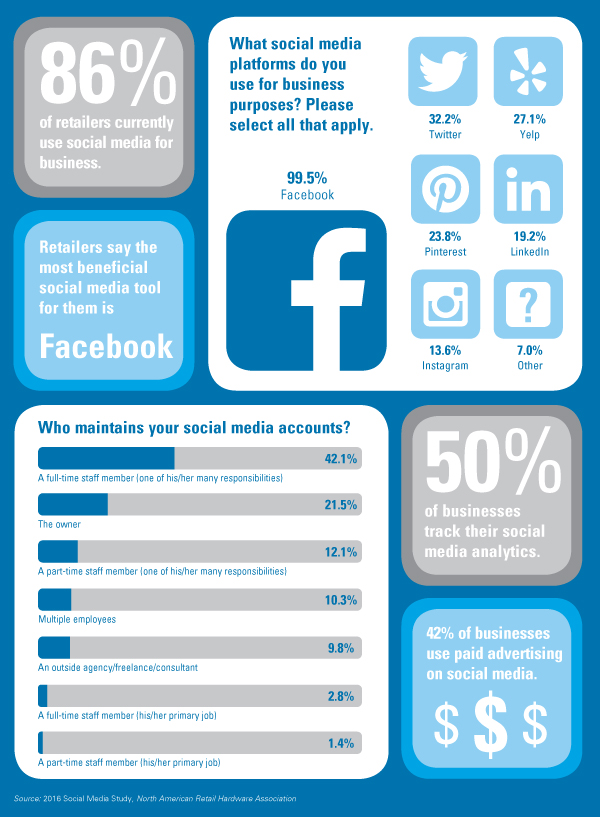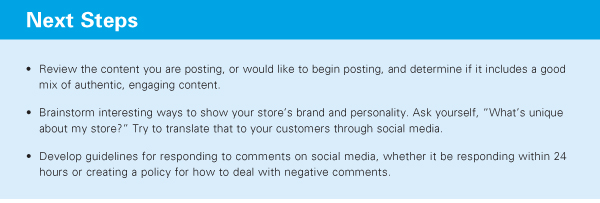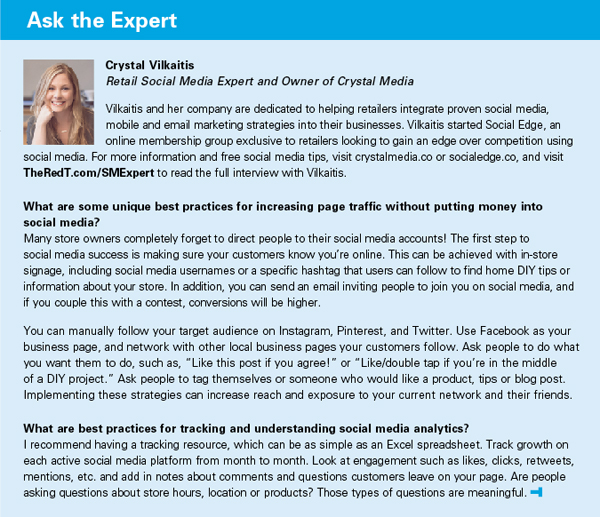Click here for a PDF of the story and download a social media package that includes best practices, an analytical tracking template, content calendar and more.
Room For Improvement
By Hilary Welter, hwelter@nrha.org and Sara Logel, slogel@nrha.org
While more retailers are engaging in social media, a large percentage of home improvement retailers are less than pleased with their efforts.
In fact, according to a recent survey conducted by the North American Retail Hardware Association (NRHA) only 2 percent of respondents identified their social media efforts as “excellent,” while 46 percent classified their efforts as “fair” or “poor.”
So, while more retailers are engaging in Facebook, Twitter, Pinterest and Instagram, most seem to feel they have a long way to go.
To determine what takes a store’s social media presence from fair to excellent, Hardware Retailing spoke with retailers who have high-performing social media accounts. These retailers are using strong, effective content and utilizing social media as an advertising tool to connect with customers.
In the following pages, we will help you evaluate your social media presence and encourage you to think about the following questions:
• Is your current process effective?
• Are you posting strong content?
• Are you actively growing your following?
• Are your efforts working?
By providing some insight into these topics and sharing firsthand examples from retailers, we aim to offer you tools and inspiration to amp up your social media engagement.
At the end of the story, Crystal Vilkaitis, retail social media expert and owner of Crystal Media, will provide her professional suggestions on best practices for growing a social media following and how to track and analyze social media results. You can read a full Q&A with Vilkaitis here.
Before we explore the previous questions, you may be asking, “Is social media worth it?” You probably run circulars, have a website and occasionally advertise through TV or radio, so does your business need social media, too?
Data from a recent NRHA consumer poll, which surveyed 1,000 consumers, shows that more than 30 percent of respondents follow businesses on social media, for reasons such as finding new products and learning about deals.
Using social media for your business provides you the opportunity to have a personal touchpoint with your customers.
“Connecting with the customer is key for us,” says Glenda Lehman Ervin, VP of marketing for Lehman’s in Dalton, Ohio, “and social media is a great way to find out what they are interested in. It is truly worth the time and effort we put in to it.”

Is Your Current Process Effective?
With the everyday hustle and bustle in an independent home improvement store, social media might be the last thing you have time to think about. But you can make the process easier by identifying two key factors: your target demographic and a plan for managing your accounts.
Knowing Your Customer Demographic
With countless social media platforms available, determining where your customers are spending their time is crucial.
“You have to look for what’s popular in your area and across your customer demographic,” says James Cabirac, owner of Kief Hardware in Cut Off, Louisiana. “And beyond that, think about the age of the customer you’re trying to reach.”
For example, Facebook is a popular platform among Kief Hardware’s older customers, but Instagram elicits attention from a younger crowd.
Equally important to understanding the different social media platforms is your location and the type of customer you’re trying to reach.
“If you’re in a large metro area and your business is mostly B2B, you might want to be really involved on Twitter and LinkedIn to find professionals and communicate with them,” says Jared Sawyer, owner of Sawyer’s True Value & Just Ask Rental in The Dalles, Oregon. “If you’re in a college town, you will want to be on younger demographic platforms and talk to them in a way that’s meaningful to them.”
For Sawyer, a lot of his customers are older and less than 5 percent are millennials, so Facebook is his main focus. However, to get the younger generation more engaged, Sawyer and his team created a Snapchat account that provides the younger demographic with laid-back and entertaining content, such as pets customers bring into the store or sales associate playing pranks on one another.
There is no right or wrong answer when choosing a social media platform, or platforms, for your business. To evaluate your current accounts, or to get started, do your research. Ask yourself, who is my target audience, and what social media platforms are they on? And, if you’re not sure, create an online or in-store survey for customers or pull data from your store’s loyalty program.
Account Management
Once you have committed to using social media for your business, the next step is to identify who is responsible for creating content and overseeing the process.
Sawyer has help from his staff to post content to the store’s different social media platforms. However, he monitors all of the accounts to ensure all posts are aligned with the store’s brand.
Ervin has a team of staff members who use scheduling tools to regularly post to the store’s accounts. There are many scheduling tools available for free online, such as Hootsuite and TweetDeck, that make it easy to schedule posts days, weeks or even months in advance. Facebook also has a built-in scheduling feature. While scheduling can be helpful, it is important to check posts to ensure all content is still relevant. For example, if you schedule a post about an event, but decide to cancel it, you’ll want to make sure to delete the post before it deploys.
Cabirac is responsible for posting all content to his store’s Facebook and Instagram accounts, but he often involves his staff in content creation. He believes that regardless of who is posting to the store’s accounts, posts should be coming from the voice of the store, not an individual person.
“When it comes to Instagram and Facebook, it’s Kief Hardware,” Cabirac says. “It’s not me. I would answer something differently on Facebook as Kief Hardware than I would as James Cabirac. I want Kief Hardware to have its own personality.”
And the best way to develop a personality for your company on social media is to share strong content that is relevant to your followers.


Are You Posting Strong Content?
You may be using social media platforms where your store’s target audience is active, but if your posts lack substance, you will not be able to break through the clutter to reach your customers. How do you distinguish your store from the rest?
Variety
When posting, it is important to consider several topics. For example, Ervin and her team share photos of products, events and people inside the store on Lehman’s Instagram page. They also use Pinterest to share DIY projects, gift ideas and advice, such as winter skin care tips or ways to use Mason jars.
Cabirac explains it is important to take a subtle approach when promoting his business.
“I’m really more interested in making our posts entertaining than making a hard sell,” Cabirac says. “I’m more about product placement than saying ‘here is this item.’”
For example, Cabirac and his staff produced a video that featured a person cutting into a watermelon in the store. Neither the post nor video came out and said, “We sell watermelon,” but the video implied it. The next day, the store sold out of watermelons.
Another great approach to posting about products is to consider what your vendors or manufacturers are doing online.
Emily Stine, of Stine Media, who handles all social media efforts for Stine Home + Yard’s 12 locations in Louisiana, says she works with the stores’ vendors to use their images and graphics on the company’s social media. She also recommends sharing posts and photos that vendors have posted to their own pages, while adding a local twist such as, “Find this drill at your local Stine Home + Yard.”
Authenticity
Stine gives social media a personal touch by posting images with people, whether they are sales associates, members of the Stine family or customers shopping in the store or winning prizes from store contests and sweepstakes.
Cabirac says sharing fun pictures or videos is a great way to engage. For example, the Kief Hardware staff produced a video in-store titled “Grease” that involved a story line of the staff going back in time, acting, lip-syncing and dancing to songs from the famous movie, “Grease.” The video entertained customers and showed personality.
Cabirac believes that it is crucial to put genuine effort into social media in order to grow your audience. “No matter if we have 100 people following us or 5,000, we always put the same effort into social media, because that’s how we got to the engagement level we’re at today,” Cabirac says.
Engagement
One huge benefit of social media is that it gives you an opportunity to interact with your customers in real time. And, engaging your followers is also important for building and sustaining your brand. If someone tweets at you or comments on your Facebook post, reply back and stay present.
“If you join the conversation, you need to stay in the conversation,” Ervin says. “Don’t put social media there and expect it to explode without checking it. It’s a relationship platform.”
For Stine, the ideal time frame to respond to customer comments is within one hour.
“The reason we like to respond within the hour is because once [the customer] sees you’ve responded quickly, whatever complaint they had tends to go away, because they see how responsive you are as a company, and they’re pleased with that,” Stine says.
Stine uses a predetermined, customizable template to respond to negative comments, keeping responses prompt and consistent.
Cabirac, along with 80 percent of respondents to NRHA’s 2016 Social Media Study, responds to all comments. He avoids deleting any comments and responds within the comment thread on social media to display Kief Hardware’s character.

Are You Actively Growing Your Following?
If you are frequently updating your social media pages, it is likely that new followers are occasionally trickling in. However, if you want to see exponential growth, there are ways to proactively drive traffic to your store’s social media accounts.
Contests, Giveaways and Sweepstakes
One way to get people engaged and to grow your following organically is to hold a contest, giveaway or sweepstakes using social media.
Along with displaying in-store signage with Sawyer’s True Value’s different social media platforms, Sawyer tries to use different promotions to create awareness around the store’s accounts.
For example, last year the store held a Halloween-themed pet contest, where customers dressed their animals in costumes and posted photos to social media. The store promoted the contest on Facebook, but people could only vote for their favorite participant on Instagram. This converted traffic from Sawyer’s True Value’s Facebook page to followers on its Instagram account.
Using cross-platform growth is a great way to inform customers of the different ways they can engage with your brand.
During the 2014 holiday season, Cabirac organized a giveaway that awarded $10,000 in gift cards to one grand prize winner. Customers had about five weeks to enter an unlimited number of times and could do so by liking, sharing or checking-in at Kief Hardware. To earn the entry, customers had to show a cashier that they’d engaged with the store on social media. Customers could also earn entries through the company’s text program and by making in-store purchases, but the store’s Facebook following skyrocketed as a result of the sweepstakes.
“We got around 500 new page likes, which may not seem like a lot, but in no other form of advertising can I say that I reached 500 new people who now know what my store is and what we’re about,” Cabirac says.
The key to growing your following is to encourage people to share your content, especially on Facebook, as shares are incredibly valuable.
“’Likes’ mean, ‘I like what you said,’ but ‘shares’ means, ‘I like it so well that I gave it to my friend, who then gave it to two of her friends, who gave it to four of her friends…that’s how you go viral,” Ervin says.
Paid Advertising
In addition to sweepstakes and giveaways, another way to reach new audiences and drive traffic to your page is through paid advertising. Utilizing paid advertising options through Facebook allows you to target ads to Facebook and Instagram users based on specific criteria, including demographic information, but also very specific areas of interest. With a wide variety of advertising options available through the platform, you can spend as much, or as little, as you want on these ads.
Stine Home + Yard contributes 20 percent of its advertising budget to Facebook advertising. The company takes advantage of different ad options to encourage potential and existing followers to “Like” the company’s Facebook page, advertise specific products, drive traffic to the website, distribute coupons and promote events, videos and sweepstakes.
Each month, the company reaches approximately 300,000 people within 10 miles of a Stine Home + Yard location at an average of six times in their Facebook News Feed with Facebook advertising.
Recently, the company engaged in a detailed Facebook ad campaign that involved a series of targeted carousel ads for tools sold at Stine Home + Yard. As a result of the Facebook ads, tools sales were up 40 percent.
Stine says Facebook sweepstakes and advertising has helped the company collect over 10,000 emails and gather approximately 100,000 Facebook page likes over the past four years, while engaging their audience with fun content.
To reach the company’s target audience, Stine uploads the company’s email list, then Facebook matches the customers’ emails with their emails on Facebook.
Another targeting feature available is Lookalike Audience, which finds attributes of the individuals identified in your email list, and creates a very similar segment to target ads to. Ads can also be targeted at people who currently like your store’s page, friends of people who like your page, individuals with specific interests and more.
Sawyer also uses Facebook to run specific, targeted ads about once per month. He uses Facebook advertising to target dog food information to pet owners or sports attire to college students in his area. He also used Facebook to promote an in-store event around fire safety. He created a post targeted at women ages 20-45 with children who lived within 25 miles of the store and were not currently RSVP’d to the event on Facebook, along with a few other criteria.
The examples provided by these retailers only brush the surface of the advertising options available through Facebook. The possibilities are abundant. To learn more about Facebook advertising, visit www.facebook.com/business.

Are Your Efforts Working?
If you’re putting in the effort to create unique posts, engage your customers, run contests and maybe even post ads on social media, it is essential to know if your efforts are effective.
Cabirac consistently checks his Facebook analytics and uses an app called “Followers” to track when people follow and unfollow Kief Hardware’s Facebook page.
“It’s important to see what struck a chord with people so you know what to post next time,” says Cabirac. “You can see what people are responding to each day. If I see a lot of people drop, I pay attention to who’s dropping and why they might be doing that.”
Stine also tracks posts frequently and tracks everything from followers, post likes and shares to overall engagement. She also measures the company’s ads for clicks, engagement and the total cost it takes to reach their audience.
“Metrics on Facebook are far superior to anything you can get from any other channel, whether it’s print, TV or whatever,” Stine says. “You can truly measure anything.”
To track Lehman’s social media accounts, Ervin uses Google Analytics and the analytic tools provided by each platform to determine information like referral websites and how long people are viewing videos. One team member evaluates each platform regularly and reports to the larger group on a quarterly basis. They review trends and determine what has worked over the past month.
“It is important to regularly look at what your customers do on social media and determine an action plan,” Ervin says. “If we post a five-minute video and the drop-off rate shows that everyone stopped watching at one minute, our customers are telling us the video is too long. We will use that information in creating the next video.”
In order to help you analyze your efforts, we’ve created an analytic tracking template you can use each month to evaluate your company’s social media engagement. This template includes tracking formulas for several data points, and allows you to easily compare engagement month to month.
This template is part of a Ask the Expert larger social media toolkit that is available to download. Other elements of the package include:
• Scheduling Template: This spreadsheet will help you create a plan for posting social media content to your accounts. The template allows you to plan out post details including date, time, social platform and person responsible for posting. It can also help you ensure that your social efforts are in sync with store events and promotions.
• Social Media Best Practices: We’ve summarized best practices from this story, and have added on a few more tips in this list of top 10 things to consider while using social media. This reference is perfect for evaluating and improving your current social media processes.
• Facebook Page Builder: There are several components that make a great Facebook page. This quick, visual guide will help you determine if your company’s page includes all of the essentials to make it a user-friendly and informative resource.


 Hardware Retailing The Industry's Source for Insights and Information
Hardware Retailing The Industry's Source for Insights and Information






